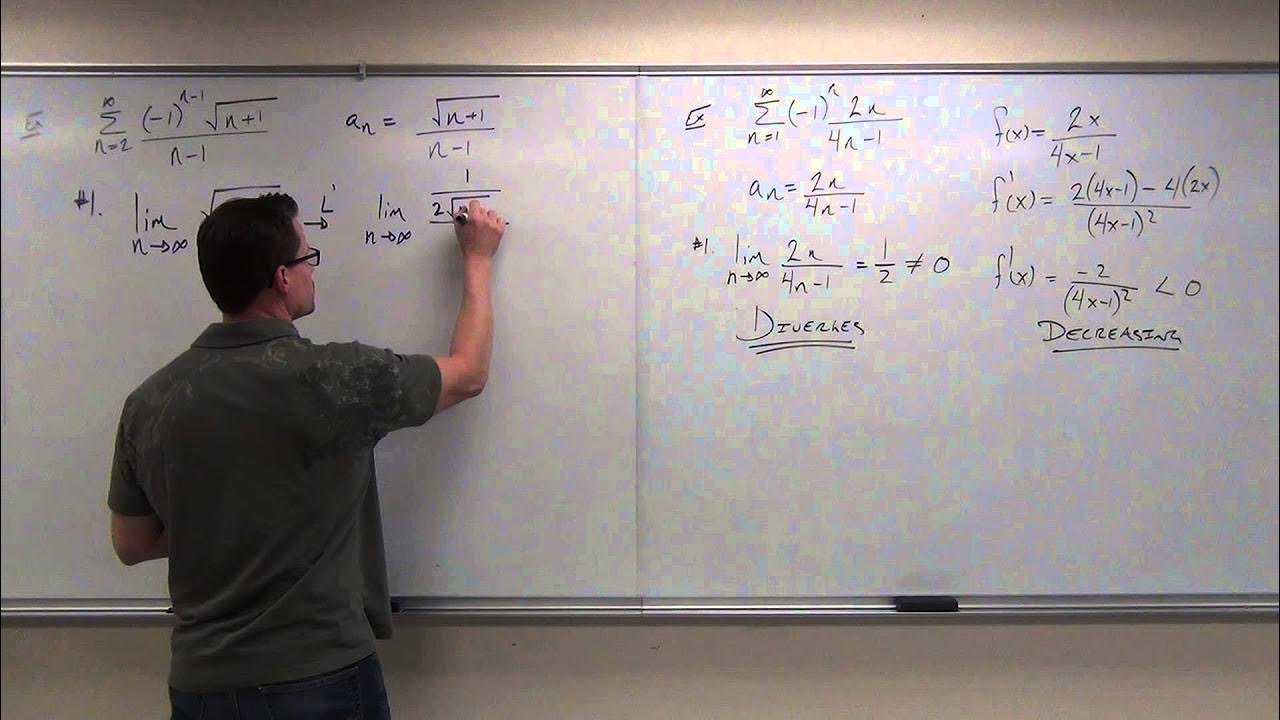Worked example: alternating series remainder | Series | AP Calculus BC | Khan Academy
TLDRThis video explores the convergence of an alternating infinite series, \((-1)^{n+1} / \sqrt{n}\), and focuses on estimating its sum, denoted as S. The series passes the alternating series test, confirming convergence. The presenter guides viewers in calculating the minimum number of terms, k, required for the remainder to be less than 0.001, using the alternating series remainder property. The solution involves solving an inequality to find k ≥ 999,999, ensuring the series sum is within one thousandth of the actual value. The script concludes with a verification step to confirm the remainder's absolute value remains within the specified limit.
Takeaways
- 🔍 The video discusses an infinite series with alternating signs and a power of -1 raised to the power of n over the square root of n.
- 📈 The series is visualized by expanding the first few terms, showing a pattern of positive and negative terms that decrease in magnitude.
- 📚 The series passes the alternating series test, confirming its convergence, but the focus is on estimating its sum, denoted as S.
- 🔢 Estimation of the series sum is achieved by calculating a partial sum of the first k terms and analyzing the remainder.
- 🔍 The remainder after the first k terms is denoted as R sub k and starts with the (k+1)th term of the series.
- 📉 The absolute value of the remainder R sub k is less than or equal to the absolute value of its first term, a key property of alternating series.
- 🔑 The goal is to find the minimum number of terms, k, such that the absolute value of the remainder is less than or equal to 0.001.
- 🧩 The inequality to solve is derived from the remainder's first term, which simplifies to 1/√(k+1) ≤ 0.001 after manipulation.
- 🔎 Solving the inequality leads to the conclusion that k must be greater than or equal to 999,999 to satisfy the condition.
- 🏁 The smallest k that meets the condition is 999,999, ensuring that the remainder's absolute value is less than one thousandth.
- 📝 The video script also encourages viewers to verify the result by examining the partial sum of the first 999,999 terms and understanding the behavior of the remainder.
Q & A
What is the infinite series being discussed in the script?
-The infinite series discussed is the alternating series: negative one to the n plus one over the square root of n.
What does the script mention about the convergence of the series?
-The series passes the alternating series test, which means it converges.
What is the main goal of the script in relation to the series?
-The main goal is to estimate the value to which the series converges by using partial sums and determining the minimum number of terms required for the remainder to be less than or equal to 0.001.
How is the partial sum of the series represented in the script?
-The partial sum of the series is represented as S sub k, which is the sum of the first k terms of the series.
What is the remainder in the context of the series, and how is it represented?
-The remainder is the part of the series that remains after taking the first k terms. It starts with the k plus first term and is represented as R sub k.
What inequality must be satisfied to find the minimum number of terms (k) for the remainder to be less than or equal to 0.001?
-The inequality that must be satisfied is 1 over the square root of k plus one ≤ 0.001.
How is the value of k determined from the inequality?
-By solving the inequality 1 over the square root of k plus one ≤ 0.001, multiplying both sides by 1,000, and then squaring both sides, we find k must be greater than or equal to 999,999.
What is the smallest value of k that satisfies the inequality?
-The smallest value of k that satisfies the inequality is 999,999.
How is the absolute value of the remainder shown to be less than or equal to the first term of the remainder?
-It is shown by recognizing that the absolute value of the remainder is dominated by the absolute value of the first term, which is 1 over the square root of k plus one.
Why can't the remainder be more negative than the first term?
-Because the remainder starts at the first term, which is -0.001, and subsequent positive terms make it less negative.
How is it demonstrated that the remainder cannot be more positive than 0.001?
-By rearranging the parentheses to group negative values together, showing that the sum of these groups will be negative, ensuring the absolute value of the remainder cannot exceed the first term's value.
Outlines
📚 Understanding Infinite Series Convergence
This paragraph introduces an infinite series with alternating signs and terms involving the square root of n. The series is visualized by expanding the first few terms, demonstrating how it alternates between positive and negative values. The main focus is not on whether the series converges, but on estimating its sum, denoted as S. The concept of partial sums and remainders is introduced, with the goal of finding the minimum number of terms (k) such that the absolute value of the remainder is less than or equal to 0.001. The viewer is encouraged to pause and think about how to estimate this convergence.
🔍 Estimating Series Convergence with Minimum Terms
The paragraph delves into the specifics of estimating the convergence of the series by calculating the remainder after taking the first k terms. The remainder, R sub k, is described starting from the (k+1)th term, and it's explained that the absolute value of the entire remainder is less than or equal to the absolute value of the first term in the remainder. The goal is to find the smallest k such that this absolute value is less than 0.001. The viewer is prompted to pause and attempt to solve this inequality. The solution involves recognizing that the absolute value of the series will be less than the absolute value of the first term, leading to the inequality 1/√(k+1) ≤ 0.001. Solving this inequality gives k ≥ 999,999, indicating that at least 999,999 terms are needed for the remainder to be within the desired threshold.
📉 Verifying the Remainder's Absolute Value
This paragraph validates the previous conclusion by examining the partial sum of the first 999,999 terms and the corresponding remainder. It explains that the remainder starts with the millionth term, which is negative due to the alternating signs, and that the absolute value of the remainder will be less than the absolute value of the first term in the remainder. The viewer is encouraged to consider the impact of additional terms on the convergence and to understand that the remainder will not deviate more from the actual sum than the first term. The conclusion is that the absolute value of the remainder will not exceed one thousandth, confirming the earlier estimate of needing at least 999,999 terms.
Mindmap
Keywords
💡Infinite Series
💡Convergence
💡Alternating Series Test
💡Partial Sum
💡Remainder
💡Estimation
💡Square Root
💡Absolute Value
💡Inequality
💡Minimum k
💡Alternating Series Remainder Property
Highlights
Introduction of an infinite series with alternating signs and terms involving negative one raised to the power of n plus one over the square root of n.
Visualization of the series expansion to understand the pattern of positive and negative terms.
Application of the alternating series test to confirm the convergence of the series.
Introduction of the concept of partial sums and remainders in the context of infinite series.
Objective to estimate the series' convergence value by determining the minimum number of terms required for the remainder to be less than 0.001.
Explanation of how the remainder R sub k is calculated starting from the (k+1)th term.
Concept of the alternating series remainder property, where the absolute value of the remainder is less than or equal to the absolute value of the first term.
Setting up the inequality to find the minimum k such that the absolute value of the remainder is less than 0.001.
Realization that the numerator in the remainder expression flips the sign, simplifying the inequality.
Manipulation of the inequality by multiplying both sides by the square root of k plus one and then by 1000 to isolate k.
Solving the inequality to find that k must be greater than or equal to 999,999.
Conclusion that the smallest k satisfying the condition is 999,999.
Verification that the absolute value of the remainder is less than one thousandth by examining the first term of the remainder.
Demonstration that the remainder cannot be more negative than the first term, ensuring the absolute value is less than 0.001.
Further verification that the remainder cannot exceed a positive thousandth by considering the series' alternating nature.
Final assurance that the partial sum of the first 999,999 terms will have a remainder within the desired precision.
Transcripts
Browse More Related Video

Calculus 2 Lecture 9.5: Showing Convergence With the Alternating Series Test, Finding Error of Sums

The Root Test

Conditional and Absolute Convergence for Infinite Series

Worked example: Series estimation with integrals | Series | AP Calculus BC | Khan Academy

Alternating Series, Types of Convergence, and the Ratio Test

Alternating series remainder | Series | AP Calculus BC | Khan Academy
5.0 / 5 (0 votes)
Thanks for rating: